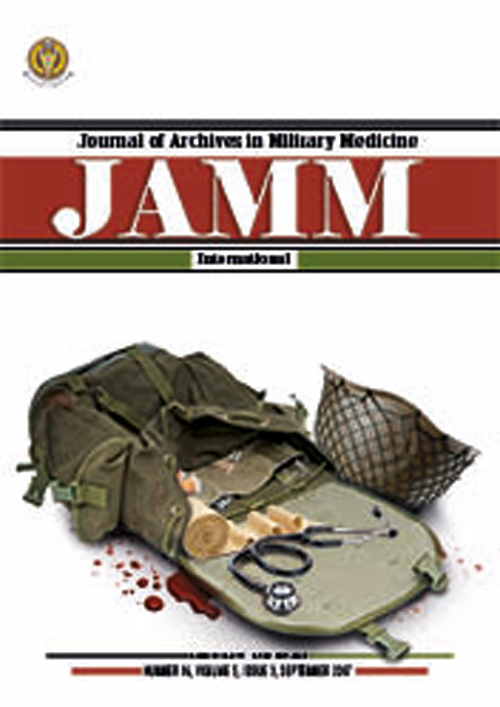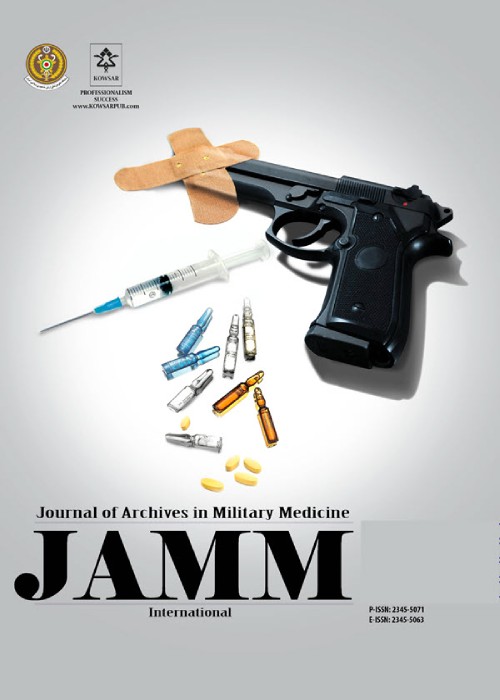فهرست مطالب

Journal of Archives in Military Medicine
Volume:5 Issue: 3, Sep 2017
- تاریخ انتشار: 1396/08/21
- تعداد عناوین: 8
-
-
Page 1Modern diagnostic and therapeutic procedures including advanced surgeries, organ transplants, and immunotherapy are pillared by antimicrobial therapy. Parallel to the rising incidence of infectious diseases, the menace of antimicrobial resistance (AMR) emerged worldwide. Developing countries are facing the brunt in epidemic proportions due to huge population, substandard housing, overcrowding, rapid unplanned urbanization, deterioration in water and waste management systems, strained public health infrastructure, and limited resource allocation to healthcare. Simultaneously, AMR has adversely affected the outcome of military injuries. The rising problem of AMR is discouraging the development of newer antimicrobials by the pharmaceutical industry. There has been a considerable impetus towards concept development; however, the magnitude of the problem overshadows the progress made towards the control of AMR worldwide. There is a dire need to identify this threat, develop concerted multipronged strategy, develop infrastructure, foster expertise, and take coordinated and urgent steps to tackle the serious public health challenge. An intensified commitment needs to be taken up on a war footing at individual, local, national, regional, and international levels. This article discusses the overall concept for developing countries.Keywords: Antimicrobial Resistance, Panresistance, Totally Drug Resistant Tuberculosis, Hospital Infection Control, Antimicrobial Stewardship
-
Page 2BackgroundThe medical community fails dramatically in the understanding of chronic diseases and development of causal therapies. Statistical associations between vaccinations or infections and autoimmune diseases or a multitude of chronic diseases remains without any scientific rational. The Gulf War illness, with an unexpected high health risk (34%) for military personnel after a manifold of vaccinations, points to the need of a scientific approach different from insufficient linear clonal selection concepts in immunology.MethodsNon-linear dynamics analyzed in time series, phase portraits, and mathematical models.ResultsThree different types of chronic diseases, different from lasting acute diseases, are discriminated by Cerebrospinal fluid analysis and nonlinear dynamics. A nonlinear model for a virus-driven chronic disease explains the chronification of the infection, as one of the stable optional states between complete immunity and death. The model also helps create causal therapies and facilitating phase transitions to complete immunity based on individual connectivity in the immune network. Chronic diseases with a sudden change from stable health to a pathological but stable state are phase transitions based on metabolic fluctuations spontaneous or facilitated by external influences (via the immune, endocrine or nervous system). A reduced complexity in diseases is shown by the numerical analysis of time series (e.g., heart rate) or attractor phase portraits. In chronic diseases, with immune system associated pathology, vaccination or infection has to be regarded as a facilitator for a phase transition, like a catalyst, but not as the cause. With this causation we understand why no traces, like causative antigens, are found in Gulf War illness, chronic fatigue syndrome, post lyme syndrome, or the mild encephalitis in schizophrenia.ConclusionsThe complexity approach shows why antiviral or antibiotic medications fail in chronic diseases. Disease as an emergent property should be investigated on the phenotype level. Nonlinear analysis of time series of the individual patient gives information not available from group statistics of molecular multiscale systems or systems biology. New research perspectives could base on the extended time of registry after vaccinations and should focus on causal therapies, which need financial support, independent from the medical-industrial complex, with its divergent interests.Keywords: Autoimmune Diseases, Gulf War Illness, Fuch's Heterochromic Cyclitis, Post Lyme Syndrome, Vaccination, Therapy, Chronic Diseases, Complexity Analysis, Nonlinear Dynamics, Time Series, Phase Transition
-
Page 3Vaccination has had great success in history of medicine with both infectious and non-infectious diseases listed in the realm of vaccines. The significant decrease in deaths from infectious and non-infectious diseases by development of vaccines has had a huge impact on the world health. Since the 20th century, for preventive and treatment purposes, there has been an emergence of new and diverse range of vaccines in medicine. Also, there are ongoing extensive efforts to increase the efficiency and performance of vaccines and reduce the risks, which are associated with humans. Despite of the development of advanced and effective vaccines in the recent decades, vaccines should be presented with different mechanisms to prevent epidemic and pandemic diseases. Vaccination has received the greatest attention in military aspects and several vaccines have been developed. Therefore, it seems that the study of different types and generations of vaccines, understanding their evolution, and production and development of new and modern vaccine is essential.Keywords: Vaccines, Medical Science, Prevention, Treatment
-
Page 4BackgroundSleep deprivation, weighted road march combined with short term high intensity physical activities are important aspects of army ranger operations, which can lead to inflammation, muscular injury, and physical and shooting performance loss. On the other hand, animal and human studies documented that choline supplement relieves inflammation and improves physical and mental performances. The aim of this study was to examine the effect of choline supplementation on serum creatine kinase and IgA, macular endurance, and shooting accuracy of army rangers following one-day simulated operation.MethodsTwenty army rangers voluntarily participated in this double-blind, placebo controlled quasi-experimental study. The subjects were divided to 2 equal groups and randomly assigned as choline (n = 10, age = 21.2 ± 3.2 years, Vo2max = 37.7 ± 4.9 mL/kg/minute) and placebo (n = 10, age = 21.2 ± 2.2 years, Vo2max = 38.7 ± 6.6 mL/kg/minute) groups. Choline supplement (2 gr choline bitartrate/day) or placebo (a tea spoon of acid citric/day) was administrated one week before the day of simulated operation, which included partial sleep deprivation (22 p.m.-1a.m.), 19.3 km weighted (12 kg) road march, and 4.8 km competitive run test without extra weight. Serum CK and IgA, muscle endurance (upper body, lower body, and abdomen), and shooting accuracy were assessed before and on the day following the simulated operation. The data were analyzed using independent samples T test (subtracting pretest from posttest) and paired samples t test.ResultsThere were no significant changes in serum CK and IgA, abdominal muscles endurance and shooting performance in choline and placebo treatments from pre to the post test, while the posttest upper and lower body endurances were significantly (PConclusionsThe results of this study showed that choline supplement does not induce any positive effects on post operation outcomes of inflammation, muscle injury, muscle endurance, and shooting accuracy.Keywords: Choline, Inflammation, Sleep Deprivation
-
Page 5BackgroundPatients with colon cancer are at risk of developing functional impairment. However, studies on functional status in this population are limited.ObjectivesThe aim of this pilot study was to evaluate the functional status in patients with colon cancer and determine its association with sociodemographic and disease-related characteristics and perceived family support.MethodsThis cross-sectional study included 30 patients (53.3% males) with colon cancer who were followed up by an oncology outpatient clinic in a military hospital in Turkey. Data were collected using a personal data form, the Functional Living Index-Cancer (FLIC), and the Cancer Patient Social Support Scale.ResultsThe total mean FLIC score of the patients was 112.9 ± 22.4. Female gender and lower levels of family support were associated with poorer functional status (PConclusionsThe functional status of the patients was higher than the moderate level. A greater understanding of factors associated with functional status in patients with colon cancer could provide appropriate interventions to support functional performance and improve health outcomes.Keywords: Colon Cancer, Family Support, Functional Status
-
Page 6IntroductionVancomycin-resistant Enterococcus (VRE) infection of prosthetic joints is an unusual infection. When it does occur, it is difficult to treat, as treatment options are limited and often fraught with difficulties.
Case Report: We present a case of a patient with a VRE-infected total knee arthroplasty that was treated with a two-stage revision along with six weeks of intravenous and intraarticular daptomycin with a good outcome.ConclusionsA protocol for treating VRE in prosthetic joint infections has yet to be established and further randomized controlled studies are warranted for the management of such infections.Keywords: Intraarticular Antibiotics, Prosthetic Joint Infections, Total Knee Arthroplasty, Vancomycin, Resistant Enterococci -
Page 7Migrating intracranial bullets are a dilemma to neurosurgeons, as their management is challenging, and the removal process is associated with high mortality and morbidity rates. They are also associated with alterations in consciousness and focal neurological defects. We herein report a 40-year-old man with a retained intracranial AK-47 bullet for 22 years, admitted to our emergency department with decreased level of consciousness. He was diagnosed with meningitis and obstructive hydrocephalus, given the pressure effect of the bullet over the aqueduct of Sylvius. He underwent placement of external ventricular drainage (EVD) and received broad-spectrum antibiotics. However, he passed away due to complications of meningitis. Postmortem examination revealed that the bullet had entered the anterior perforated substance from ethmoidal air cells and migrated to the brain ventricular system in 22 years. Accordingly, conservative management of intracranial retained bullets is recommended.Keywords: Intracranial Bullet, Gunshot Wound, Migrating Bullet, Hydrocephalus, Decreased Level of Consciousness


